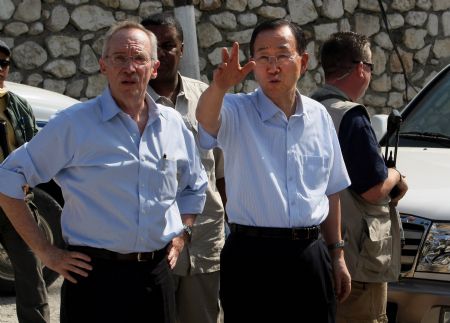UN chief arrives in quake-hit Port-au-Prince
The United Nations Secretary General Ban Ki-moon arrived on Sunday in Port-au-Prince, the capital of Caribbean nation Haiti, which was destroyed by a Tuesday quake that registered 7.3 on the Richter scale.
Ban came to see first hand the effects of the catastrophe, to show solidarity to Haiti's citizens and to the UN's workers, as well as to help boost the speed of aid distribution in the nation.
He began with an inspection of the UN headquarters in Port-au-Prince, which collapsed in the quake killing both Hedi Annabi, the UN's special representative in Haiti, and his deputy Luiz Carlos da Costa alongside dozens of UN staff.
Annabi, a Tunisian who led the United Nations Stabilization Mission in Haiti (Minustah), was found dead on Saturday by Chinese rescue workers in the ruins of the building.
Ban also met quake survivors, telling them that rescue teams and international aid are being accelerated.
"I am here with a message of hope, that aid is already on the way," said Ban, a South Korean, during a press conference at the National Palace, the presidential seat.
During the same conference, Haiti's Prime Minister Jean-Max Bellerive estimated that around 100,000 people had died due to the quake and that more than 90 percent of the nation's buildings are damaged, adding that these were estimates and not final figures.
At a separate Sunday meeting with Spain's Deputy Prime Minister Maria Teresa Fernandez de la Vega, Ban proposed a special UN-backed European Union mission to Haiti, which shares the island of Hispaniola with former Spanish colony the Dominican Republic. Spain is the current holder of the rotating, six-month EU presidency.
The UN is evaluating the opening of a so-called humanitarian corridor linking the Dominican Republic and Haiti, in order to boost the number of sources of aid, given that Port-au-Prince airport has been overwhelmed by the large number of planes arriving from across the world.
 0
0 







